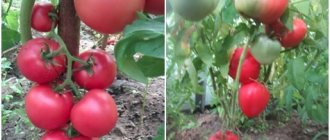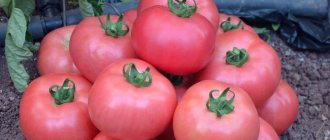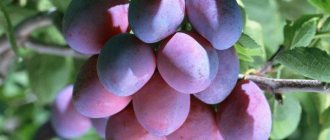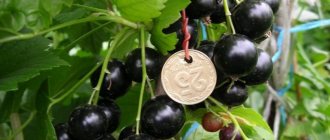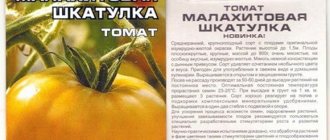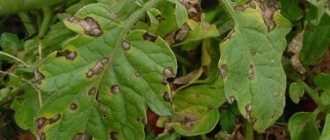In our country, the word “Hospitable” is not a simple one; it explains the generosity of the Russian person, his ability and desire to benefit his neighbor. And if a tomato variety is named with this word, you should expect a lot from it. Did this really happen? The question is debatable, you need to familiarize yourself with the characteristics of this tomato, where and how it bears fruit.
- 2 Appearance of fruits
- 3 Advantages and disadvantages, differences from other varieties
3.1 Video: Khlebosolny tomato in a garden bed in the Kirov region
Productivity
The Khlebosolny tomato enters the fruiting phase in the mid-early period. Approximately 105...115 days pass from the moment of germination to the harvesting of the first fruits. One cluster bears 4…5 fruits. Fruiting in terms of elongation is considered average.
The State Register sets the yield of the variety at 8.3 kg/m2. Gardeners note that this figure is slightly underestimated, and with proper care and good weather during the season, it is possible to harvest much more tasty tomatoes - 4...5 kg per bush.
Resistance to diseases and pests
The characteristics of the variety indicate the resistance of the Khlebosolny tomato to fusarium, tobacco mosaic virus and cladosporiosis. The plant tolerates long-term temperature drops to +15 +18 degrees combined with high humidity.
To reliably protect plantings from the development of fungal diseases, it is necessary to carry out preventive spraying 2-3 times per season.
They begin processing Khlebosolny tomato seedlings after planting them in the garden. They use the drugs Fitosporin, Trichodermin, whey solution (1 glass per bucket of water), garlic infusion.
The following biological products are effective against pests that parasitize tomatoes (aphids, spider mites, cutworms, whiteflies): Fitoverm, Verticillin, Bitoxibacillin. Treatment should be carried out at the first signs of the appearance of insects, without waiting for their numbers to increase.
Pros and cons of the Khlebosolny tomato
The Khlebosolny variety has a number of advantages that have made it widely known among Russian gardeners. These include:
- good taste and marketability of fruits;
- resistance to any vagaries of weather;
- low maintenance requirements;
- stable yield;
- resistance to tomato diseases.
Khlebosolny has no significant drawbacks - this variety is an ideal combination of taste, productivity and resistance to the vagaries of the weather. However, in almost all cases there is a need for additional gartering of the clusters during fruiting, otherwise the branches may break.
Tomatoes Salted, video
The producer of seeds of this variety is the agricultural company Siberian Garden.
If you grew Khlebosolnye tomatoes, please write whether you liked them or not. What was the yield and taste of the fruits like under your climatic conditions? How do you assess the resistance of this variety to pest diseases? Write briefly the advantages and disadvantages of this tomato in your opinion. If possible, attach a photo of the entire bush or individual fruits you grew to your comment. Thank you!
Your reviews of the Hospitable tomato and additions to the description will help many gardeners evaluate this variety more objectively and decide whether it is worth planting or not.
All varieties of tomatoes with photos, descriptions and reviews from gardeners are here >>>> Tomato catalog in alphabetical order
Features of cultivation
Khlebosolny is grown using the standard seedling method. At the time of planting, the age of the seedlings should be 55...60 days. By this time, they will have formed a strong root system, a thick trunk up to 30 cm high and 8...10 leaf blades.
The seedlings are planted on a pre-prepared planting site according to the standard pattern of 40x60 cm or 50x50 cm. Thus, 3...4 plants will be placed per 1 m2 of area. Hospitable shows the best yield values when formed into 2 or 3 stems. Some gardeners grow plants with 4 stems, but the fruits will grow smaller in size. Since the bushes are quite branchy, you should not thicken the standard planting scheme.
A distinctive feature of the Khlebosolny tomato variety is its rapid rooting in a new place. Usually, no problems arise after planting the bushes - they quickly adapt to new conditions and begin to grow.
During the season, standard care operations are carried out - regularly, but moderately, watering, weeding and loosening the soil under the bushes. To achieve high yields of Khlebosolny, fertilizing should not be neglected. They are especially important at the flowering and fruiting stages. At the same stages, it is recommended to hill up the bushes. This event is aimed at developing and strengthening the root system of plants.
Hospitable practically does not need stepsoning. You can step it up moderately or do without this operation altogether. Rationing of flower ovaries is not necessary, but is necessary for growing giant fruits. If a gardener has set this particular goal, he should leave no more than 5 flowers on different racemes on one bush. All other ovaries and flowers are blinded (cut off). Thus, there will be few fruits, but their weight will be enormous.
In general, Khlebosolny bushes are not tied up, but especially heavy clusters may need additional support or garter.
Area of application of fruits
Tomatoes of this variety are considered to be salad tomatoes - due to the large size of the fruits and pleasant taste. Therefore, collected tomatoes are used to add to vegetable salads or prepare various snacks.
These tomatoes are also added when preparing soups or sauces. Since the pulp of Khlebosolny tomatoes is quite fleshy, they make excellent tomato juice, which is used fresh or canned for the winter.
Important!
Due to their large size, the fruits of the Khlebosolny variety are not suitable for whole-fruit canning; they are usually cut into slices and added to salads, which are preserved for the winter.
Photo of tomato pulp of the Khlebosolny variety
Reviews from gardeners who planted
Since Khlebosolny is a variety widely known among summer residents, on the Internet you can easily find many comments and reviews from those who have already encountered its cultivation in practice. Having analyzed the reviews, it can be noted that almost all gardeners throughout Russia managed to obtain a high yield of tomatoes with good fruit characteristics. But there are also rare cases when people fail to grow this variety for several seasons in a row.
Medinilla:
“I really love this variety. Previously, there was no greenhouse; I grew it under film. Now they are planted in the greenhouse annually. Hospitable never let you down. One of the first to ripen. To prevent the tomatoes from being clumsy, I pluck out the double flowers. Otherwise there would be even more tomatoes. The tomatoes are large, fleshy, not at all sour, with a rich tomato taste.”
Gggalina:
„The most favorite variety. It is declared as average, but in reality it belongs to the early ones. Very tasty and productive. The flesh is fleshy, but not dry. If the tomatoes in the brush are smaller, their size is larger. Ripe fruits are not stored for a long time - no more than two weeks.”
Mrs. Tomato:
“I planted it in open ground. The variety meets all the declared characteristics, I liked the taste and yield.”
Natalia:
“I grow bread-salting plants only in open ground. Once I tried to plant it in a greenhouse, the result was worse. I don’t tie up the bushes; I put boxes under the bunches as a support.”
Lars01:
“I’m cool about large tomatoes, but the name itself intrigued me, so I bought a bag of seeds. I asked my friends about the variety, they said that it was very popular at one time. The growing result is excellent. I picked the first tomato from the bush, tasted it and burst into bliss. I think it will be great for juices and ketchups. Productivity is high.”
Controller07:
“We plant different varieties of tomatoes – for canning, for salads, and just to eat a large tomato with salt. Khlebosolny has been delighting our entire family for several years now with its large fruits. The fruits are very tasty, sweet, fleshy. The bushes grow up to 80 cm.”
Characteristics of the bush
Continuing to consider the characteristics and description of the Khlebosolny tomato variety, it is time to get acquainted with the above-ground part of the crop. The bush is determinate, although it can grow in height from 0.8 to 1 m. The plant is very spreading. Tying the stems to the support is required. Additionally, you need to support heavy fruits so that the brushes do not break off the branches.
The variety is considered mid-season, since the ripening of tomatoes begins on the 120th day. In the south and in the middle zone, the Khlebosolny tomato can be grown outdoors. In the northern regions, the closed method is more suitable. And it doesn’t matter what the greenhouse is made of. The Khlebosolny variety grows well under film, glass or polycarbonate.
Tomatoes of Siberian selection are famous for their resistance to poor growing conditions. The Khlebosolny variety is not lagging behind in this regard. The plant easily tolerates dry summers, temperature changes and sudden cold snaps. The tomato is slightly susceptible to fungus, rot and other viral diseases.
How to grow seedlings
Successful cultivation of tomatoes depends on quality seedlings . To prevent plants from stretching out, observe the timing of planting seeds. Sowing is carried out in the second half of March. Before planting the plants in a permanent place of growth, the bushes will become stronger, grow up to 25 cm and have 3 pairs of leaves.
Seed preparation
For good germination, the seed must be fresh . Seed material is purchased at a gardening store or collected from your own harvest.
Before sowing, suitable grains are selected by soaking the seeds in salt water for 5-10 minutes (10 g of salt per 1 liter of water). The grains that float to the surface are of poor quality, they are thrown away, the rest are selected for planting. Next, suitable seeds are washed in clean water and placed in a 1% solution of potassium permanganate for 20-30 minutes, washed again and sprayed with a growth stimulant, for example, Heteroauxin, Epin or Kornevin.
To quickly hatch the seeds , two days before sowing, the grains are wrapped in damp cotton cloth. The saucer with them is placed in a cool, dark place. The gauze with seeds is periodically moistened.
Container and soil
Seeds are sown in special seedling boxes or plastic containers . Cut-off milk or juice boxes are also used, but most often seedlings are grown in peat cups or tablets. Several holes are made at the bottom of plastic or cardboard containers to drain excess liquid.
When sowing seeds in peat products, the process of plant picking is simplified . The glass along with the seedlings is placed in a large container. Over time, peat becomes limp and dissolves in the soil, and the plants themselves are not injured or stressed during transplantation.
To obtain strong seedlings, use high-quality soil:
- ready-made soil mixture for seedlings;
- self-prepared soil - mix garden soil, humus, sand (sawdust), wood ash in a ratio of 2:1:1:1.
Before use, the soil is disinfected - watered with boiling water or a weak solution of potassium permanganate. This procedure destroys all larvae and bacteria that cause plant diseases.
Sowing
The seeds are laid out in the grooves made according to a 3x5 cm pattern . When using disposable cups, plant no more than 1-2 seeds in one container. The grains are deepened into the soil by 1-1.5 cm and sprinkled with a thin layer of sand and earth mixed in equal parts.
Next, the soil is carefully sprayed with a sprayer so as not to erode the soil. To do this, use settled water at room temperature. The container is covered with transparent glass or film and placed in a warm place.
Growing and care
The temperature in the mini-greenhouse is maintained at 21-23 ° C , and air humidity is 60%.
Before germination, the container is periodically ventilated so that condensation does not appear and mold does not form on the soil surface in the future. Also, seedlings are regularly moistened with warm water, preventing the soil from drying out.
A week later, when shoots appear, the shelter is removed and the air temperature is lowered to 15-17 °C for 5 days. This procedure stimulates the growth of the root system and prevents the stretching of seedlings. After this time, the plants are returned to a warm place.
The Khlebosolny variety is a light-loving plant , so the crop is provided with lighting for at least 14-16 hours a day.
If the seeds were planted in one container , then when the first true leaves appear, the plants dive. To do this, water the tomatoes well, an hour after moistening, carefully remove them along with the soil and place them in separate containers. The lack of soil is replenished with a nutrient mixture of garden soil and humus (1:1).
Before planting seedlings in a permanent place of growth, the plants are hardened off. This way tomatoes take root better in a new place and grow quickly. Two weeks before transplanting, the bushes are taken outside or onto the balcony for a couple of hours. The time spent by tomatoes in the fresh air increases every day.
Harvesting and application
The fruits of this variety ripen in about 4 months . The harvest is harvested in the morning, when the sun is not shining. Some vegetable growers harvest tomatoes green. Vegetables ripen perfectly at home. If you want to collect your own seeds, wait until the tomatoes are fully ripened.
The Khlebosolny tomato is considered a salad variety . Vegetables are used to prepare various dishes; they are suitable for baby and diet food. Tomatoes are also processed into juice, tomato paste and ketchup.
Attention! Tomatoes are not suitable for canning: the size of the vegetable will not fit into the neck of the jar.
Advantages and differences of the variety
The Khlebosolny variety adapts well to weather conditions. It tolerates slight drops in temperature and even short-term night frosts without consequences. Productivity does not decrease due to heat, rain and short breaks in watering.
The advantages of the Khlebosolny tomato include the following characteristics:
- resistance to infections;
- high quality seedlings;
- shade tolerance;
- fruit size;
- long-term fruiting.
The disadvantages include the dependence of the yield on the level of agricultural technology, the composition and fertility of the soil. Not everyone is delighted with the taste of the fruit. Some gardeners consider it average, although the majority like it.
Novosibirsk breeders created the Hospitable pink tomato. It is not inferior to Khlebosolny, and in some respects even surpasses it. Tomatoes store better and taste better. The photo shows how large and beautiful the fruits of Hospitable Pink are.
Tomato “Demidov”, photos, reviews In order for the harvest to please the summer resident, you need to follow the correct agricultural technology, love your job and, most importantly, good varieties...
Watering rules
Khlebosolny is an excellent variety; tomatoes are undemanding to watering, but this does not mean that they do not need to be watered at all. Moisten the soil under them only when it is clearly drying out. Water early in the morning or late in the evening. You should not water tomatoes during the day, as this leads to the appearance of perspiration inside the bushes, which contributes to the occurrence of fungal diseases.
Types of Brachychiton and description of home care
In general, the Hospitable pink tomato and other varieties of the variety are not subject to any diseases with proper care. As for pests, they, of course, can appear. You need to get rid of them on time and it is advisable to use environmentally friendly control measures. Vegetable growers use insecticides only against spider mites.
Tomatoes of the Khlebosolny variety are fed no more than three times per season with an interval of 14 to 20 days.
To avoid the appearance of harmful insects on the bushes, it is advisable to treat them with a weak solution of potassium permanganate; it is even better to use phytosporin. This can be done in the early morning or late evening, but not in foggy weather.
On a note! You can provide yourself with the seeds of these wonderful tomatoes.
Olga Danilina
Cultivation care
Caring for the “Hospitable” variety is easy. However, to get a good harvest, the following procedures must be followed:
- Tying. Since the bush is spreading, without tying the stems will break. The bush needs to be tied to a support.
- Topping. As soon as the plant reaches a height of 80 cm, the growing point should be pinched. In addition, you need to regularly pick off the lower leaves.
- Watering. The variety is able to tolerate drought, but do not forget about soil moisture. Plants need to be watered once a week. Ash can be added to water.
- After the procedure, you need to loosen it, so the root system will receive air.
- Hilling. During the season, 2 hillings will be required.
- Feeding. After moistening the soil, you can apply organic or mineral fertilizers. Potassium and phosphorus have proven themselves well. Much less nitrogen is required.
In addition, plants need microfertilizers. Experienced summer residents prefer magnesium and boron. Boric acid can be used to spray bushes.
Transplantation into the ground
Seedlings begin to be transplanted into the ground at the end of May or early June. The Khlebosalny tomato is planted in the greenhouse earlier - at the end of April or beginning of May. 3-4 holes are placed per 1 m². After transplantation, seedlings are watered and the soil is mulched. The stake support is placed immediately.
The variety is large-fruited, so it needs regular feeding. During the season, the Khlebosolny tomato needs to be fed at the root at least 5 times. During flowering, treat the leaves with a solution of boric acid (water - 1 l, powder - 1 g).
Comment! Hospitable tomato seeds retain their varietal characteristics and can be used for propagation.
Bushes in the ground produce 1-2 stems. In a greenhouse, it is recommended to grow a Khlebosalny tomato with 3 stems. All unnecessary stepsons are broken out. The procedure is repeated every 5-7 days. Leaves are removed only at the bottom of the stem. They are picked after the first fruits appear. In August, the buds are picked off so that all the fruits have time to ripen.
Water the Khlebosalny tomato once every 5-7 days. Surface watering weakens the root system, so the soil is soaked to a depth of 40 cm. To reduce moisture evaporation, the bed is covered with a layer of mulch. Organic materials are used (straw, dried lawn grass).
